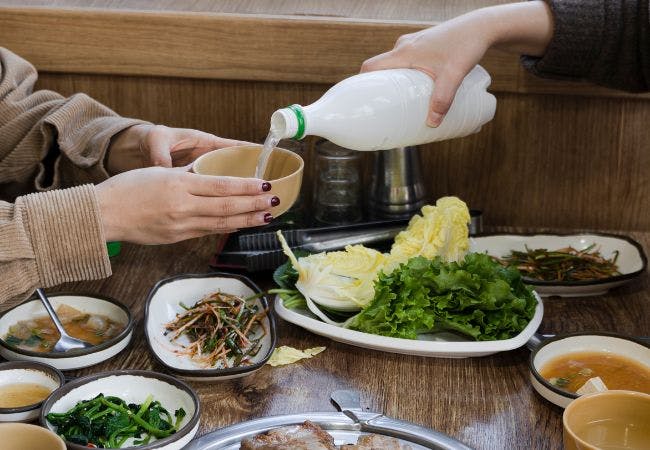your cart
Your cart is empty.
Guide to Drinking Makgeolli (Korean Rice Wine)
At 6-8% ABV, makgeolli is a great communal drink and wonderfully unique alcoholic beverage. Find out more about this popular Korean drink.

Makgeolli (pronounced mahk-oh-lee) is a drink unlike any other. The Korean rice wine has been enjoyed for centuries and remains a popular alcoholic drink in Korea today, seeing a renewed resurgence in recent decades. This increased interest has spread worldwide, with many people outside of Korea reaching out to try this traditional beverage.
The tangy, milky and fizzy qualities of makgeolli make for a unique profile and experience. If you’re keen to try more Asian alcohol, you’ll certainly want to give this one a try. Here’s everything you need to know about drinking, storing and enjoying makgeolli.
What is Makgeolli?
Traditionally, makgeolli was homebrewed, making it a farmer’s or peasant’s drink. It has been known by other names like nonju, which means ‘farmer’s brew’. This is because it was easy, cheap and quick to make, with surplus rice crops being fermented with one-step fermentation known as danyangju.
In its most basic form, makgeolli is made with rice, nuruk (a fermentation starter) and water. Brewing takes just 7-10 days.
The resulting drink is creamy and fizzy – some may also refer to it as takju, which means ‘cloudy alcohol’.
Nowadays, many of the commercial makgeolli brands will sell a range of makgeolli types and flavours to cater to the drink’s resurgence and renewed popularity with the younger generation.

What Does Makgeolli Taste Like?
Often likened to yoghurt drinks, makgeolli is slightly sour, tangy and sweet. The complex flavour makes for a wholesome drink on its own but it also pairs especially well with savoury and spicy Korean foods.
Because it has such a simple brewing process and is largely unfiltered, it can also have a chalky or grainy texture, with sediment settling at the bottom.
Is Makgeolli Alcoholic?
The alcohol content of commercially sold makgeolli is around 6-8%. Traditional homebrews tend to have a higher percentage of alcohol (up to 18%) as they are not watered down in order to make exploration easier.
It is a relatively mild beverage and is considered a communal drink that can be enjoyed for any occasion.
Soju Vs Makgeolli
But how does makgeolli compare to Korea’s other super popular alcoholic drink – soju?
Soju tends to be stronger than makgeolli at around 20%. It is sometimes called ‘Korean vodka’ and has a much drier texture and profile. Despite also sometimes being made from rice, soju is far smoother.
Ultimately the two drinks offer very different experiences. To find out more about soju and its differences, read our ultimate soju guide.

Is Makgeolli Healthy?
Like all alcohols, makgeolli should be enjoyed in moderation, but it also offers some perhaps surprising health benefits.
Makgeolli Benefits
When unfiltered, makgeolli can be very nutritious, fibrous and vitamin-rich, also containing lactic acid and lactobacillus bacteria. This is what makes yoghurt good for gut health and digestion, meaning makgeolli can help with the same benefits.
Other proposed health benefits of drinking makgeolli include anti-inflammatory and immune-boosting properties and the support of blood circulation.
What to Eat with Makgeolli
There’s nothing better than enjoying a drink and meal with friends. But if makgeolli is your drink of choice, what kind of food should you pair it with?
Makgeolli is a great complement to spicy Korean dishes as it helps neutralise the fiery kick and mellow some of the heat. Enjoying it with any kimchi dishes is a given! Other bites that work well include things like:
- Korean seafood scallion pancakes
- Fried chicken
- Crispy beef
- Pork belly
Ultimately, anything hearty and delicious is going to pair well with makgeolli.

How to Drink & Serve Makgeolli
Makgeolli should always be served cold/chilled, usually in shallow bowls rather than glasses. Traditionally, it is served with a ladle or out of a brass kettle.
If you’re drinking it mixed, gently turn the bottle upside down several times to unsettle the sediment – be careful, as it is fizzy. If you prefer to drink it unmixed, let the sediment settle and gently pour out the clearer liquid.
Makgeolli can be drunk on its own or with mixers in a makgeolli cocktail.
How to Store Makgeolli
You should keep most makgeolli in the fridge. Pasteurised options may last longer than unpasteurised bottles, but once opened, you should really drink any makgeolli shortly after, within the day or next few days.
Fresh makgeolli will continue to ferment in the fridge, changing in flavour over time. Unopened pasteurised makgeolli can have a shelf life of up to a year and can usually be stored at room temperature until you are ready to open them.
Where to Buy Makgeolli
Makgeolli can be easily sourced from your nearest Korean supermarket or from an online Asian grocery store for an even more convenient option. Here at Oriental Mart, we stock a range of Kooksoondang makgeolli in several flavours, including banana, peach and grape to ensure you can give this tasty, distinctive drink a try.
And check out all our delicious Korean food and ingredients, too, for a real treat for the tastebuds!
this site uses cookies
We and our advertising partners use cookies on this site and around the web to improve your website experience and provide you with personalised advertising from this site and other advertisers. By clicking allow, you accept the placement and use of these cookies for these purposes. Learn More


